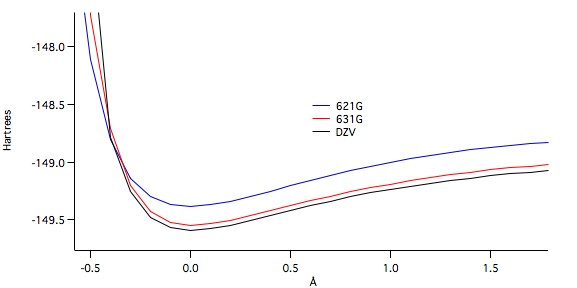Oxygen
The displays on this page were all completed using the best optimized geometry calculations. The level of ab initio
theory used was double zeta valence (DZV). Oxygen is a triplet since it
has two unpaired electrons in the molecular orbital, thus a
multiplicity of three was used on the calculations of this molecule.
Since there are unpaired electrons present in this molecule,
calculations were run under both UHF and RHF optimization calculations.
Whichever yielded the lowest energy would be the correct form to use.
UHF yielded the lowest energy, thus UHF optimization settings were used
for the O2 molecule.
This display shows the optimized geometry of O2
with bond length in nanometers for the DZV basis set. The bond length is
0.120nm which is very close to the experimental value of 0.12075nm
obtained from the NIST website1. The error is only 0.6%. The
bond lengths obtained from the 6-21G and 6-31G basis sets are 0.124nm
and 0.119nm respectively. Bond angle between the oxygen atoms is 180
degrees.
| ||||||
This image displays the highest occupied molecular orbital (HOMO) for
the oxygen molecule. The HOMO is found by dividing the number of
electrons of the molecule by two. So, since there are 16 electrons for
oxygen, 8 would be used for the HOMO. Diatomic oxygen has two HOMO's
because it consists of degenerative pairs that are flipped about the
bond axis 180 degrees. From the model, it is seen that the HOMO orbitals
would be anti-bonding. By clicking on the image the energy of the
orbital will be displayed.
| ||||||
| ||||||
This image displays the sigma 2s non-bonding orbital. The
energy of the orbital can be found by clicking on the picture of the
molecule.
| ||||||
This image displays the sigma
2s anti-bonding orbital. The energy of the orbital can be found by
clicking on the picture of the molecule.
| ||||||
This image displays the pi 2p bonding orbital. The energy of
the orbital can be found by clicking on the picture of the molecule.
| ||||||
The image displays the sigma 2p bonding orbital. The energy of the
orbital can be found by clicking on the picture of the molecule.
| ||||||
This image is a live display of O2 vibrating at the vibration frequency of 1767.04cm-1.The literature value for vibrational frequency of O2 from the NIST website is 1580.2cm-1.1
|
The dipole moment of O2 was found using the DZV basis set, and it yielded a value of 0.00 Debye. This is consistent with the experimental values since O2 is a homo-nuclear diatomic yielding no dipole moment.
The following display shows a plot of the potential energy of bond stretching at all three ab initio levels of theory. It is very evident from the plot that DZV yields the lowest energy. As the basis sets get larger the potential energy decreases.

References
1. National Institute of Standard and Technology. http://cccbdb.nist.gov/. Accessed February 2014.
HOME
Page skeleton and JavaScript generated by export to web function using Jmol 14.1.8 2014-02-10 21:43: on Mar 9, 2014.